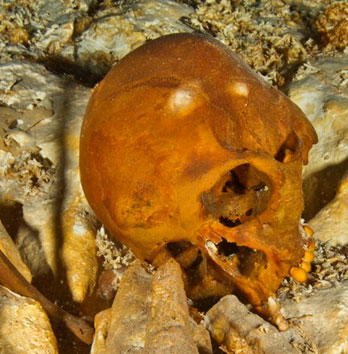
Underwater discovery in submerged Mexican cave provides glimpse of First Americans
The oldest complete Ice Age skeleton found in an underwater cave in Mexico may help solve a long-standing mystery regarding the identity of the earliest inhabitants of America and how they are related to later Native Americans, according to a new study published in the journal Science.
National Geographic reports that divers were mapping submerged caves in Mexico’s Eastern Yucatan Peninsula around 12 miles north of the city of Tulum, when they came across the most complete skeleton of its age ever found in the Americas, dating back between 12,000 and 13,000 years old. The ancient skeleton, which has been named “Naia” (ancient Greek for ‘water nymph’), belongs to an adolescent girl who fell more than 100 feet to her death nearly a half mile inside an elaborate network of caves that were largely dry at the end of the Pleistocene era.

Divers search the walls of Hoyo Negro, the underwater cave on Mexico's Yucatán Peninsula where the ancient skeleton was found. Photo credit: Roberto Chavez Arce
The skeleton is incredible significant as it has enabled scientists to connect an early American skeleton with modern Native American DNA for the first time, suggesting that the earliest Americans are indeed close relatives of modern Native Americans and provides new clues as to how the Americas were first populated.
One of the greatest mysteries surrounding Native American ancestry is the fact that ancient skulls found in the Americas are larger, and their faces narrower and more forward-projecting than those of modern Native Americas. In fact, the features of ancient skulls more closely resemble native peoples of Africa, Australia, and the southern Pacific Rim than they do their supposed American descendants. This has led some experts to argue that Native Americans arrived in a later migration to the earliest inhabitants, who came from elsewhere.
However, the newly discovered skeleton contains both the craniofacial features of ancient Paleoamericans and mitochondrial DNA possessed by later Native Americans (haplogroup D1). This suggests that the differences in features between Paleoamericans and modern Native Americans may be the result of evolutionary changes over a period of some 9,000 years, rather than being the result of separate migrations from south-east Asia or even Europe.

The skull of Naia, the teenage girl who died 12,000 to 13,000 years ago. Photo credit: Roberto Chavez Arce
The skeleton was initially studied underwater using photography, videography and three-dimensional modelling. But due to risks posed by unauthorized dives in the area, the skull and other bones were removed from the cave and further studied by an international team of anthropologists, archaeologists, geneticists, and geologists led by anthropologist James Chatters, owner of Applied Paleoscience. He was also the first to study Kennewick Man, a 9,300-year-old skeleton found in Washington in 1996. Kennewick Man also shows distinctive Paleoamerican traits rather than modern Native American traits, which has resulted in a nearly decade long legal and scientific battle regarding who he belongs to and where he originated.
While the results of the study provide solid evidence that ‘Naia’ was maternally related to Native Americans today (haplogroup D1 is only found within this population), to suggest that this proves that there were no earlier inhabitants of the Americas is far too great a leap. Naia may have been the result of interbreeding between two distinct populations that co-existed for a time, accounting for why she has both Paleoamerican features and Native American DNA, a possibility that has not even been mentioned by reports. Therefore it cannot yet be concluded that the differences in skull features between Paleoamericans and later Native Americans is accounted for simply by evolution.
Featured image: Divers Susan Bird and Alberto Nava with Naia’s skull. Photo Credit: Paul Nicklen / National Geographic.
















Comments
There were earlier populations in Mexico than this find indicates. My research indicates that the Yucatan centers of Chechen Itza and Tulum were just under 66 million years old. Keep in mind that all the Mexican ancient cities were in some way buried and had to be dug-up and restored. The dinosaur killer impact occurred on the Yucatan coast and all of Mexico and parts of the United States was flooded and covered in silt from the Gulf of Mexico that resulted from the impact. See my blog posts: Proof: That the Mayan Cities are 65-66 Million Years Old, and Were the Mayan Cities of Chechen Itza and Tulum 65 Million Years Old?
This is one of those finds you wake up to be an archaeologist for. Amazing work and I guess from now on, we're only going to be pushing that time barrier even further back - from 12,000 to 14,000 to 20,000 and beyond. Good news!